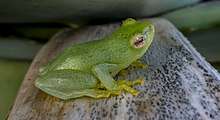Hyperolius pusillus
Hyperolius pusillus (common names: waterlily reed frog and various variants thereof, dwarf reed frog) is a species of frog in the family Hyperoliidae. It is found throughout diverse environments in eastern and southern Africa.[2] It is a very common frog. Its natural habitats are open savanna, bush land and grassland. Breeding takes place in shallow pans, vleis, open swamps, and dams with floating vegetation such as water lilies.[1]
| Hyperolius pusillus | |
|---|---|
| Waterlily reed frog from Ilanda Wilds, South Africa | |
| Scientific classification | |
| Kingdom: | Animalia |
| Phylum: | Chordata |
| Class: | Amphibia |
| Order: | Anura |
| Family: | Hyperoliidae |
| Genus: | Hyperolius |
| Species: | H. pusillus |
| Binomial name | |
| Hyperolius pusillus (Cope, 1862) | |
| Synonyms | |
|
Hyperolius microps Günther, 1864 | |
Hyperolius pusillus can resemble members of the larger Hyperolius argus species, which is also native to eastern and southern Africa.[3]
Distribution and populations
Hyperolius pusillus is found in both eastern and southern Africa. Key populations are found in southern Kenya, Malawi, and Zimbabwe. There are also populations in northern Malawi and Botswana. The species may also extend into the far west of Kenya and portions of Uganda.[1]
Hyperolius pusillus is also found in Mozambique, Somalia, South Africa, Swaziland, and Tanzania.[1] Different populations display different coloration.[3]
Coloration
The different populations vary in color. They are generally green, with darker specks covering their bodies, and different populations display patterns such as an hourglass shape (found in Kenya). Sexual dimorphism is found in the color of the throat, which is in males is white and in females green. Eyes of both the male and female are gold in color.[3]
Reproduction
Hyperolius pusillus males call from floating vegetation which is in contrast to Hyperolius viridis which calls from wet grassland.[1] The female lays batches of between 20 and 120 eggs at a time amongst floating plants.[3] Eggs of H. pusillus are light green. Tadpoles are initially green, but become green-brown with black tails as they age.[3]
Status
Hyperolius pusillus has a wide range and is a common and sometimes abundant species. The population trend is unknown but this frog faces no particular threats and seems an adaptable species, so the International Union for Conservation of Nature has rated it as being of "least concern".[1]
Gallery

- Adult frog on human hand
- Amongst vegetation
- On a tree leaf
References
- IUCN SSC Amphibian Specialist Group (2013). "Hyperolius pusillus". IUCN Red List of Threatened Species. 2013: e.T56189A3035616. doi:10.2305/IUCN.UK.2013-2.RLTS.T56189A3035616.en.
- Frost, Darrel R. (2014). "Hyperolius pusillus (Cope, 1862)". Amphibian Species of the World: an Online Reference. Version 6.0. American Museum of Natural History. Retrieved 3 July 2014.
- Schiøtz, Arne (10 September 2001). "Hyperolius pusillus". AmphibiaWeb. Retrieved 24 October 2016.
| Wikimedia Commons has media related to Hyperolius pusillus. |
